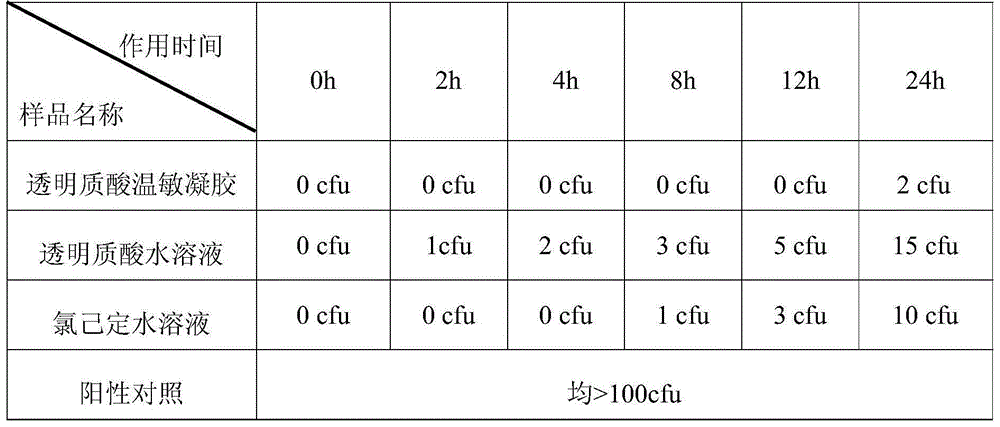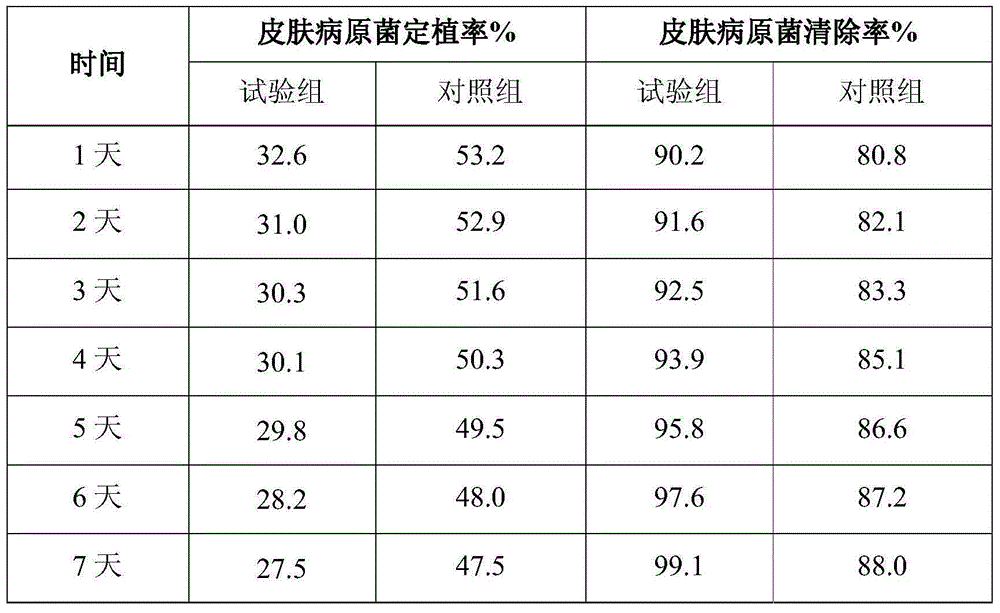Hyaluronic temperature-sensitive gel and preparation method and application thereof
A technology of hyaluronic acid and temperature-sensitive gel, which is applied in the field of medicine, can solve the problems of long-term use, short de-colonization time, unfavorable operation of medical staff, etc., and achieve the effect of accelerating healing and preventing re-colonization
- Summary
- Abstract
- Description
- Claims
- Application Information
AI Technical Summary
Problems solved by technology
Method used
Image
Examples
Embodiment 1
[0039] A hyaluronic acid thermosensitive gel, comprising the following components in mass percentage: 0.03% middle molecular weight hyaluronic acid, 0.06% small molecular weight hyaluronic acid, 0.05% chlorhexidine, 8% poloxamer 407, 0.1% hydroxypropyl Methyl cellulose, 0.05% hydroxyethyl cellulose, 0.1% polyethylene glycol, 0.1% glycerin, 0.01% pentylene glycol, 0.01% octane glycol, and the balance is water.
[0040] Medium molecular weight hyaluronic acid has a molecular weight of 1.0×10 6 Da; the molecular weight of small molecular weight hyaluronic acid is 5000.
[0041] Described chlorhexidine is chlorhexidine acetate.
[0042] The polyethylene glycol has a molecular weight of 400.
[0043] The water is purified water.
[0044] The preparation method of the above-mentioned hyaluronic acid thermosensitive gel comprises the following steps:
[0045] Step 1: Add poloxamer 407, hypromellose, and hydroxyethylcellulose into the required pure water, let stand for 24 hours, f...
Embodiment 2
[0050] A hyaluronic acid thermosensitive gel, comprising the following components in mass percentage: 0.04% middle molecular weight hyaluronic acid, 0.08% small molecular weight hyaluronic acid, 2% chlorhexidine, 25% poloxamer 407, 1% hydroxypropyl Methylcellulose, 0.5% hydroxyethyl cellulose, 1.0% polyethylene glycol, 1.0% glycerin, 0.2% pentylene glycol, 0.1% octane glycol, and the balance is water.
[0051] The molecular weight of medium molecular weight hyaluronic acid is 1.8×10 6 Da; the molecular weight of small molecular weight hyaluronic acid is 10000.
[0052] Described chlorhexidine is chlorhexidine gluconate.
[0053] The polyethylene glycol has a molecular weight of 600.
[0054] The water is water for injection.
[0055] The preparation method of the above-mentioned hyaluronic acid thermosensitive gel comprises the following steps:
[0056] Step 1: Add poloxamer 407, hypromellose, and hydroxyethylcellulose into the required pure water, let stand for 24 hours, ...
Embodiment 3
[0061] A hyaluronic acid thermosensitive gel, comprising the following components in mass percentage: 0.03% middle molecular weight hyaluronic acid, 0.06% small molecular weight hyaluronic acid, 0.3% chlorhexidine, 15% poloxamer 407, 0.3% hydroxypropyl Methyl cellulose, 0.2% hydroxyethyl cellulose, 0.5% polyethylene glycol, 0.5% glycerin, 0.01% pentylene glycol, 0.02% octane glycol, and the balance is water.
[0062] Medium molecular weight hyaluronic acid has a molecular weight of 1.5×10 6 Da; the molecular weight of small molecular weight hyaluronic acid is 5800.
[0063] Described chlorhexidine is chlorhexidine gluconate.
[0064] The polyethylene glycol has a molecular weight of 600.
[0065] The water is purified water.
[0066] The preparation method of the above-mentioned hyaluronic acid thermosensitive gel comprises the following steps:
[0067] Step 1: Add poloxamer 407, hypromellose, and hydroxyethylcellulose into the required pure water, let stand for 24 hours, ...
PUM
| Property | Measurement | Unit |
|---|---|---|
| Viscosity | aaaaa | aaaaa |
| Viscosity | aaaaa | aaaaa |
| Molecular weight | aaaaa | aaaaa |
Abstract
Description
Claims
Application Information
 Login to View More
Login to View More - R&D
- Intellectual Property
- Life Sciences
- Materials
- Tech Scout
- Unparalleled Data Quality
- Higher Quality Content
- 60% Fewer Hallucinations
Browse by: Latest US Patents, China's latest patents, Technical Efficacy Thesaurus, Application Domain, Technology Topic, Popular Technical Reports.
© 2025 PatSnap. All rights reserved.Legal|Privacy policy|Modern Slavery Act Transparency Statement|Sitemap|About US| Contact US: help@patsnap.com



